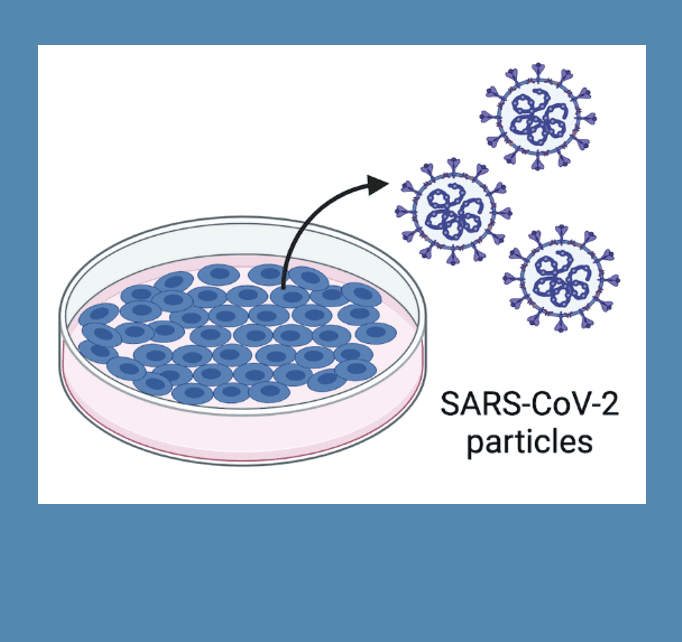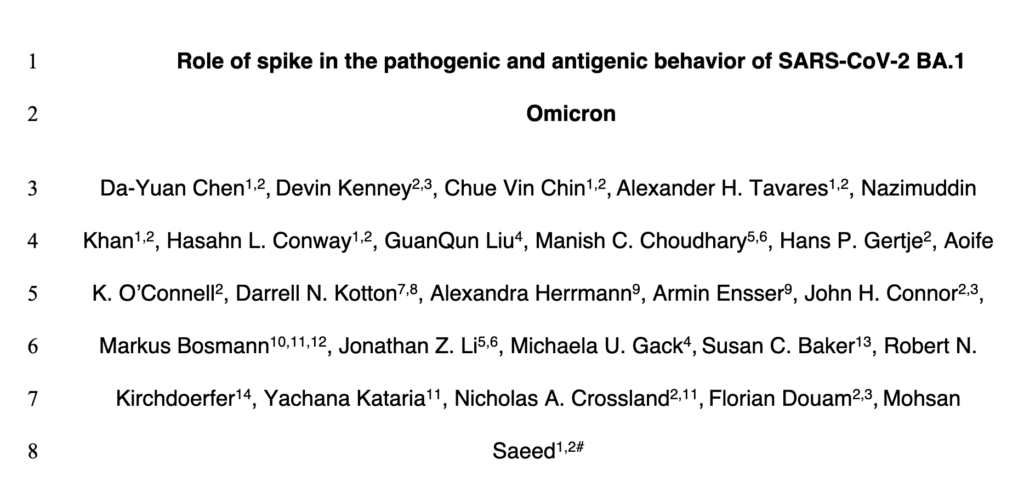Search Posts
Recent Posts
- Detailing Manhattan: Christopher Gray’s Legacy – David Brussat April 26, 2024
- Business Beat: BankNewport supports Kids’ Zone at new Save The Bay Hamilton Family Aquarium April 26, 2024
- Rhode Island Weather for April 26, 2024 – John Donnelly April 26, 2024
- GriefSPEAK: Dread. Fear. Welcome relief. – Mari Nardolillo Dias April 26, 2024
- Outdoors in RI: big animals, tiny Ticks, huge Trout, Chepachet’s Harmony Railway, 2A – Jeff Gross April 26, 2024
Categories
Subscribe!
Thanks for subscribing! Please check your email for further instructions.

BU Level 4 Lab condemned for modifying COVID virus. Researchers say guidelines not clear.
The news cycle began in the UK when the Daily Mail carried a story with this headline, “This should be totally forbidden, it’s playing with fire. Experts condemn Boston lab for creating a new deadly Covid strain with an 80% kill rate – warning it could spark a lab-generated pandemic.”
Shortly afterward, most major news sites were carrying a version of the story. The version was this. Boston University, a Level 4 bioresearch lab had been working on a modification to the COVID virus and it was showing an 80% fatality rate in lab rats.
Boston University public relations staff seems to have been blindsided by their own high-security researchers, learning about the COVID research as the UK’s Daily Mail began to circulate. The Boston University website had nothing to say until very late last night when a statement was put on their website just before midnight.
The UK Daily Mail site claimed that this was “gain of function” research – when viruses are manipulated to be even more infectious so treatment or cures could be investigated. There has been widely spread theories that the Wuhan Lab in China was engaged in “gain of function” research, perhaps even funded by the US through an intermediary biomed research group and that a lab accident could have resulted in the virus being released out into the world. Other theories say the virus had animal origins and may have come from a wet market nearby the Wuhan Lab.
The research, done by Boston and Florida researchers at BU’s lab according to the Daily Mail, involved extricating the Omicron spike and inserting it into the original COVID virus – which resulted in both greater infectious properties, from the Omicron spike, with more lethal properties, from the original COVID virus. The virus was the first new COVID virus made in the lab by this type of research in the world. A pre-print scientific paper was published which started the information circulating around the world.
Dr. Richard Ebright, a researcher from Rutgers, was scathing in his condemnation of this type of research which could develop a new and more deadly strain of virus said in Daily Mail, “The research is a clear example of gain of function research of concern, and Enhanced Potential Pandemic Pathogen (ePPP) research.
While research is necessary to be prepared for another new strain of deadly virus, regardless of where it could come from, Ebright and others said that this research did not undergo “prior risk-benefit review mandated under US-government policies”
Another researcher in the UK called the experimentation, “profoundly unwise”.
STAT News reported that “there is no evidence the work, performed under biosecurity level 3 precautions in BU’s National Emerging Infectious Diseases Laboratories, was conducted improperly or unsafely. In fact, it was approved by an internal biosafety review committee and Boston’s Public Health Commission…But it has become apparent that the research team did not clear the work with the National Institute of Allergy and Infectious Diseases, which was one of the funders of the project. The agency indicated it is going to be looking for some answers as to why it first learned of the work through media reports.” Asked if the research team should have informed NIAID of its intention to do the work, Erbelding said: “We wish that they would have, yes.”
Boston University issues statement on COVID research
Here is the statement released late at night in response to news reports circulating:
“Boston University is refuting a series of misleading claims about research at their National Emerging Infectious Diseases Laboratories (NEIDL). The reports, which first appeared on Monday in the United Kingdom’s Daily Mail, claimed researchers at the lab had “created a new deadly COVID strain.”
BU called the reporting, which was picked up by many other scientific and news outlets “false and inaccurate,” saying “this research made the virus replicate less dangerous.”
The University also noted that the research was reviewed and approved by the Institutional Biosafety Committee (IBC), which consists of scientists as well as local community members, and that the Boston Public Health Commission had approved the research.
“They’ve sensationalized the message, they misrepresent the study and its goals in its entirety,” says Ronald B. Corley, NEIDL director and BU Chobanian & Avedisian School of Medicine chair of microbiology, of the news reports.
The study set out to examine the spike proteins on the SARS-CoV-2 Omicron variant (BA.1). Researchers were interested in comparing the variant with the original virus strain, known as the Washington strain. They wanted to find out if the virus was truly less virulent, says Corley, “simply because it wasn’t infecting the same cells as the initial strain.” They were “interested in what part of the virus dictates how serious of a disease a person will get.”
But Corley says the news reports pulled one line from the paper’s abstract out of context, with the Daily Mail suggesting in its headline that the researchers had created a “deadly Covid strain with an 80 percent kill rate.” The newspaper went on to make a series of other misleading claims, including that the study was “gain of function research,” alleging researchers set out to make a more deadly virus.
Not true, says Corley. And the University’s statement strongly denied it.”
Gain of function research
“We want to address the false and inaccurate reporting about Boston University COVID-19 research, which appeared today in the Daily Mail,” said the BU statement. “First, this research is not gain-of-function research, meaning it did not amplify the Washington state SARS-CoV-2 virus strain or make it more dangerous. In fact, this research made the virus replicate less dangerous.”
Corley says the line pulled out of context actually had nothing to do with the virus’ effect on humans. The study began in a tissue culture, then moved to an animal model.
“The animal model that was used was a particular type of mouse that is highly susceptible, and 80 to 100 percent of the infected mice succumb to disease from the original strain, the so-called Washington strain,” says Corley. “Whereas Omicron causes a very mild disease in these animals.”
That 80 percent number is what the media reports latched on to, misrepresenting the study and its goals.
“This was a statement taken out of context for the purposes of sensationalism,” says Corley, “and it totally misrepresents not only the findings, but [also] the purpose of the study.”
In fact, according to BU’s statement, “this research mirrors and reinforces the findings of other, similar research performed by other organizations, including the FDA.” That’s supported by one of the lead researchers on the study, Mohsan Saeed, a NEIDL investigator.
“Consistent with studies published by others, this work shows that it is not the spike protein that drives Omicron pathogenicity, but instead other viral proteins,” says Saeed, a BU Chobanian & Avedisian School of Medicine assistant professor of biochemistry. “Determination of those proteins will lead to better diagnostics and disease management strategies.”
Stringent Safety Procedures in new research on COVID
Since its opening in 2009, NEIDL has allowed scientists to study a range of infectious diseases and pathogens in a protected environment. The lab is governed by strict safety procedures. Long before a researcher begins studying a disease or pathogen, their proposal has to go through a series of rigorous safety reviews, says Robert Davey, a BU Chobanian & Avedisian School of Medicine professor of microbiology, who is based at the NEIDL.
“Before anything is done in the NEIDL, it goes through multiple layers of careful safety review and this is done through committees that are part of Boston University and also committees that are outside of, independent of, BU, such as the Boston Public Health Commission,” says Davey. “We get a completely independent look at anything that’s about to be done. Only after all that is approved and double-checked are you then allowed to proceed with the work. And that work only occurs with the oversight of the environmental health and safety group at BU.”
The study was conducted in the lab’s biosafety-level 3 facilities. All studies are conducted in a biosafety cabinet, with researchers having to enter their workspace through a series of interlocked doors. All floors and walls are sealed, and the lab is fitted with sophisticated filtration and decontamination technology. And if the researchers had seen anything untoward during the study, they would have immediately shut it down and reported it.
“We take our safety and security of how we handle pathogens seriously, and the virus does not leave the laboratory in which it’s being studied,” says Corley. “Our whole goal is for the public’s health. And this study was part of that, finding what part of the virus is responsible for causing severe disease. If we can understand that, we can then develop the tools that we need to develop better therapeutics.”
“Ultimately, this research will provide a public benefit,” according to the University’s statement, “by leading to better, targeted therapeutic interventions to help fight against future pandemics.”
Level 4 Research Labs in US
Biosafety level 4 laboratories are used for diagnostic work and research on easily transmitted pathogens which can cause fatal disease. These include a number of viruses known to cause viral hemorrhagic fever such as Marburg virus, Ebola virus, Lassa virus, and Crimean-Congo hemorrhagic fever. Other pathogens handled at BSL-4 include Hendra virus, Nipah virus, and some flaviviruses. Additionally, poorly characterized pathogens which appear closely related to dangerous pathogens are often handled at this level until sufficient data are obtained either to confirm continued work at this level, or to permit working with them at a lower level.
Level 4 labs in the Us:
Boston, Massachusetts – National Emerging Infectious Diseases Laboratory (NEIDL), Boston University – Focus on potential threats to public health.
Hamilton, Montana – Rocky Mountain Laboratories Integrated Research Facility – Focus on vector-borne diseases.
Galveston, Texas (2) – Galveston National Laboratory, National Biocontainment Facility & Shope Laboratory. Focus on prevention, diagnosis and treatment of potentially life-threatening diseases caused by naturally emerging and purposefully disseminated infectious agents.
Fort Collins, Colorado – CDC & Colorado State Univ – specializes in arboviral and bacterial diseases.
Atlanta, Georgia – CDC – specializes in smallpox
Georgia State University – specializes in B-virus
Bethesda, Maryland – National Institutes of Health – currently only operates with BSL-3 agents
Fort Detrick, Maryland – Integrated Research Facility – animal models of human diseases
National Biodefense Analysis & Countermeasure Center – bioterrorism threats
US Army Medical Research Institute – biological threats to the U.S. military
San Antonio – Texas Biomedical Research Institute- The only privately owned BSL-4 lab in the US
Richmond, Virginia – Virginia Division of Consolidated Labs – A BSL-4 lab that also acts as a BSL-3 lab
“I’m very tired of people suggesting that virologists and NIAID are reckless or don’t care about biosafety,” a coronavirus expert at the University of Saskatchewan’s Vaccine and Infectious Disease Organization told STAT. “The problem isn’t that. The problem is that the guidelines and expectations aren’t clear for many experiments and the process isn’t transparent.”
Awareness of the controversial research began when a research “pre-print” – a non-peer reviewed article was published in bioRxiv – a pre-print service in Biology managed by the Cold Spring Harbor Laboratory – here is the actual publication:


https://www.biorxiv.org/content/10.1101/2022.10.13.512134v1.full.pdf
Professor Shmuel Shapira, a leading scientist in the Israeli Government, said: ‘This should be totally forbidden, it’s playing with fire.’
___
